Bryanna Clark Grogan’s Vegan Feast Kitchen/ 21st Century Table: The kitchen journal of a vegan food writer.. I'm on Facebook and Twitter (see links in sidebar at right).
Wednesday, May 13, 2009
MOONG DAL INDIAN "CREPES"-- MADE ONLY WITH BEANS; NO FLOUR OR GRAIN

Moong Dal "Crepes" with Indian-style sautéed Savoy cabbage and soy yogurt
I'm really excited about these Indian "crepes" (called adai or pesarattu, made only from dal [dried legume] and un-fermented)-- they are made from beans!
I have made dosa (another type of Indian "crepe") for years, but usually with some grain or flour in them, and usually with some oil in the pan. My experiment was to make them solely with soaked beans and with no more than a light spritz of oil in the pan. It was a success, and DH and my friend Holly gobbled them up. (For a filling, I used a simple cabbage stir-fry recipe from Madhur Jaffrey's World of Vegetarian Cooking, with some Tofu "Yogurt". You can use any vegan yogurt.)
We all remarked that this simple, delicious, nourishing, and filling meal was so inexpensive to make.
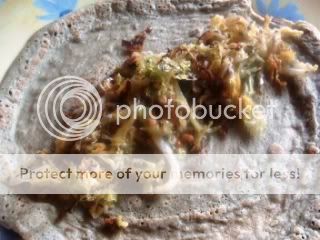
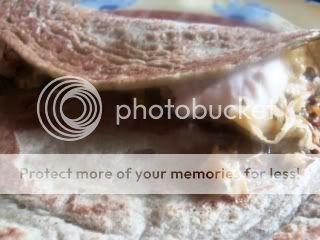
This experience has inspired me to try different kinds of Indian breads and dumplings that can be cooked in a nonstick pan, or steamed, using soaked beans, sprouted beans, bean flours, and even fresh corn. I'll let you know if I have any other successes.
Last night I soaked some moong dal in water:
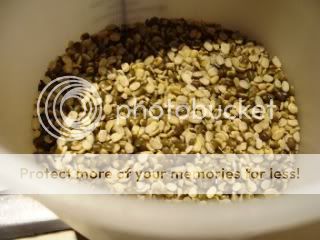
I used split moong dal, with the skins.Much later, I found my split washed moong dal
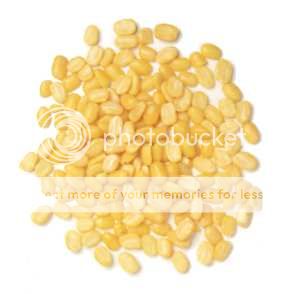
Washed moong dal
In the morning it looked like this and I had about 5 1/2 cups of soaked dal.
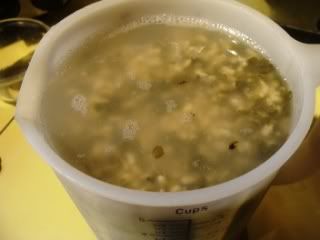
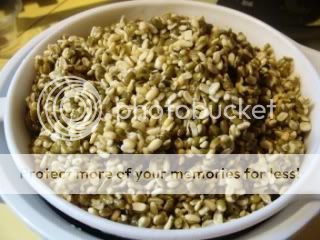
Here's the recipe:
Printable Recipe
BRYANNA'S MOONG DAL ADAI OR PESARATTU (INDIAN "CREPES" )
Servings: 12
These crepes are a type of Indian "crepe" that is made only from soaked, but not fermented, dal. These are actually a bit sturdier than the crepes we're used to, but they fold and roll nicely. You can eat them simply with chutney or an Indian-style vegetable stir-fry, or with a more elaborate vegetable curry, if you like. They can be eaten for breakfast, as a snack, or for a lunch or supper dish. (They would be great for a gluten-free diet, too.)
1 1/2 cups split moong dal
water to generously cover-- they really soak it up!
2 tablespoons (or more, according to taste) of fresh chopped green chilies (seeds removed-- or, cheat, as I did, and use pickled or canned jalapeño peppers)
1 piece (1-inch) fresh ginger, peeled
1 teaspoon salt
1/2 teaspoon cumin seed
water to thin the batter, as necessary (1/2 cup, at least)
The night before you are to make the adai, rinse and drain the dal and then place in a bowl or container with room to almost triple, and cover generously with water. The dal will soak up alot of water, so don't be stingy!
The day you are making the pancakes, make or assemble your filling(s) before starting to cook the adai.
Drain the water off the soaked dal and place it in a large high-speed blender container, along with the chilies, salt and ginger. In a Vita-Mix, you can grind the soaked beans, using the tamper, without extra water, but I don't think you could do this in cheaper blenders. In any case, I ended up adding water to the batter, so you are safe to add 1/2 cup of water to the batter when blending.
Blend the mixture until smooth, stopping and scraping down as necessary. Scoop the mixture into a bowl. Add the cumin seeds.
Now, adjust the thickness of the batter. If it's too thick, it won't spread easily. I kept stirring in water until it spread easily. I didn't measure, unfortunately, but the batter ended up like a regular Western crepe batter, more or less-- kind of like cream.
Spray a good-quality 8 to 10" nonstick skillet
With a good nonstick or well-seasoned skillet you may be able to cook these without using a spray pump with oil, but it depends on your pan. When cold water sprinkled on the pan sizzles, scoop about 1/4 cup of batter into the center of the pan with a small ladle and then use the bottom of the ladle to go in circles and spread the batter out from the center. It's easier than you might think! See the "action" pictures below (they are blurry, but give you the idea):
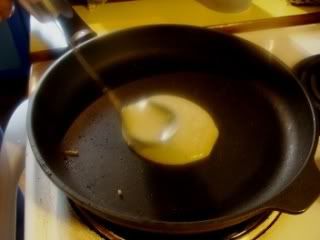
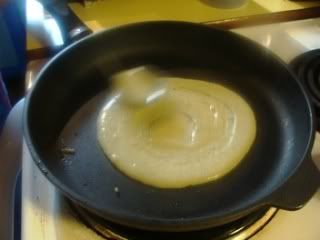
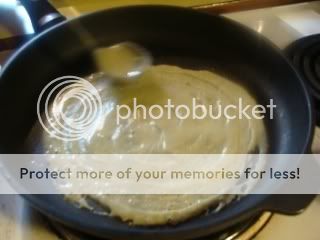
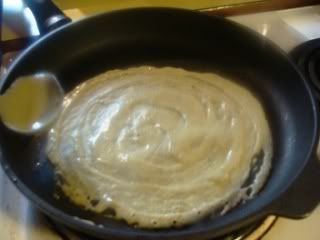
PS: if your batter doesn't spread easily, it may be too thick.
I turned the heat down just a notch or two from the "high" setting. Almost as soon as you have the batter spread, it will start looking a bit dry on top.
Carefully turn the adai and cook for a few seconds, then fold in half and lay on a platter with a clean tea towel over the adai.

Repeat until the batter is all used up. These can be refrigerated and reheated.

Nutrition Facts
Nutrition (per crepe): 90.8 calories; 3% calories from fat; 0.3g total fat; 0.0mg cholesterol; 166.5mg sodium; 327.7mg potassium; 16.4g carbohydrates; 4.3g fiber; 1.7g sugar; 12.1g net carbs; 6.2g protein; 1.0 points.
INSTRUCTIONS FOR SEASONING SKILLETS AND KEEPING THEM SEASONED , SO THAT THEY ARE VIRTUALLY NONSTICK:
Instructions for seasoning a carbon steel skillet here, here and here.
Instructions for seasoning a stainless steel skillet here and here.
Instructions for seasoning a cast iron skillet here.
If your cast iron skillet is really a mess, here is one way to restore it. If it is a rusty mess, it needs to be stripped and re-seasoned. I had an old pan like this and I did not want to use lye or oven cleaner to scrub it. I used the self-cleaning oven method described at the beginning of this article. This treatment stripped it right down to the grey iron. Then I did thorough oven-seasoning-- rub oil on all parts of the pan, including the handle; make sure there is no dripping oil; bake at about 350 degrees F for 1 hour; cool completely; repeat 3 more times. This may seem excessive, but you can do it when you are baking something at the same time, and the pan was like new!
To keep your cast iron pans well-seasoned, after cooking, add some HOT water to the pan (do not use cold) and let them soak for a few minutes. Then clean with a scrub brush (no stainless steel scrubbers, please!). Anything is stuck, use the edge of a plastic (not metal) dough scraper or the special polycarbonate pan scraper that Lodge sells for this purpose:
Dry the pan thoroughly. Rub a little oil all over the inside of the pan. Rub it in well and don't leave any excess oil. Place over low heat on the stove for 5-10 minutes. Let it cool and store.
PS: You do not need to use an expensive oil like flax oil, or even coconut oil. Your favorite neutral smelling/tasting oil will do just fine.
Enjoy!

Labels:
adai,
dosa,
gluten-free,
Indian crepes,
Indian cuisine,
moong dal,
mung beans,
pesarattu
Subscribe to:
Post Comments (Atom)
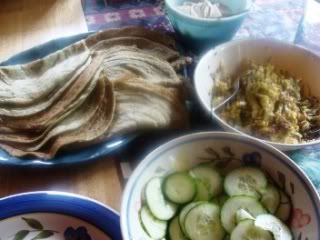
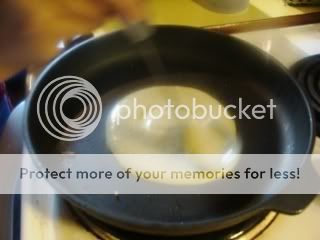

18 comments:
I am a South Indian and vegan. My mother makes dosas frequently with a mixture of white and red rice (an Indian whole grain rice) and urad dal, but I have also tried pesarattu which is like dosa but made with moong-dal and/or a mixture of other dals. I don't think we've had plain moong dal dosa before though. I'd especially like to try the other additions in your recipe, mixed into the batter as you have done. We usually flavour it afterwards, sprinkling with finely chopped herbs and raw vegetables like onion, peppers, carrot and spinach on top, when it's cooking - a bit like a Spanish omelette. Did the cabbage taste good with the dosa? I have never eaten it before with a vegetable dish (only chutney or pickle), except for masal, a spicy potato filling.
Thanks for your posts. I really appreciate them. I made a farinata with onions and herbs a few days ago and it was very good but I forgot to leave a comment.
Thanks for writing, Ka! I'm glad you enjoyed the farinata!
We liked the cabbage with the dosa. I just made that because it was quick and I had the ingredients. Also, since we are trying to lose weight, I didn't want to use anything with alot of oil, or with peanuts or coconut.
For my kids when they were young (many years ago!) I used to make rice and urad dal dosa with a spicy potato filling and yogurt (pre-vegan days-- we had a cow!). They loved that for breakfast! If you have suggestions for fillings, particularly heavy on the veggies, I would love you to share them!
Oh, and, Ka, I forgot to add that I like the idea of adding things to the dosa like an omelet!
Would you call this recipe a type of pesarattu, then, by the way?
I love the idea of using red rice in a dosa! I have some Thai red rice-- maybe I'll give that a try!
I think I could have made this recipe with an even thinner batter-- I'm going to try that next time.
Brilliant--I cannot wait to try these! Thank you for the recipe!
Oh, and congrats on the weight loss! That is great :o)
Courtney
wow, beautiful dosa! i have been wanting to make indian-style wraps for ages.
I am so impressed that those are grain free! I will have to try them. Congrats on the weight loss as well. I think if you can be creative in your cooking Core can absolutely be a positive experience without any feelings of deprivation.
These look great. I've never made anything like them but they sound so healthy and delicious. I think they would be wonderful filled with curried cauliflower and carrots.
I made those crepes yesterday, ostensibly to provide a gluten free meal for my hubby, but down deep I just love discovering new foods and new ways to cook with them!!
While I was very familiar with mung beans, I had never heard of SPLIT mung beans. Had a hard time finding them, and finally had to order them online.
But what a tasty crepe!! Your pictures Bryanna, as usual, were worth a thousand words, showing how you have to swirl these outward into a circle.
Very tasty!! I filled them with a vegan cottage cheese/mushroom/spinach filling, and topped them with a small blob of tomato sauce.
Hi: this is my first visit to your blog, and I am getting a lot of interesting recipes from your site.
I second Ka's comment that your 'dosai' is like pesarattu AKA adais (dosai made from a batter of mixed dals only, instead of dal + rice). Unlike dosais, adai/pesarattu batter is not fermented. You can use plain moong dal like you did, or mix moong, masoor, chana, urad (any or all of these) dals. You can 'up' the nutrition by adding finely chopped greens (e.g. fenugreek or spinach or amaranth) to the batter. For a lower fat meal, instead of chutney, you can make tomato or any other chutney, or even sambar.
All the best!
I tried making these but they just stuck to the pan and didn't cook through, so then I added a little flour and flax seed meal to the batter to see if i could get it to stick together and still no luck. Any tips? These look really great and I'd love a healthy crepe like that to have with meals!
Gaby, you need a really good, heavy nonstick pan to use no oil. If you don't have one, you'll have to olil the pan more generously, which is actually the more traditional way to cook them. The only other thing I can think of is that you had the heat too high and/or made them a little too thin.
Hi, this is my first time at your blog. And what a fantastic array of different recipes you have here!! Love that there are so many different types of cuisines are featured here. Keep it coming!!
Hi, I just tried making these and they also just stuck to the pan. I used a lot of oil and a non-stick pan. Maybe I used the wrong sort of beans? Would that make a difference? They tasted good but looked nothing like crepes. The batter felt very sticky. Any suggestions? I ended up pouring the batter into a baking pan and baking it in the oven, letting it cool, then slicing it up and frying the pieces.
Anonymous, I really couldn't say, not being able to see what you used. If you look at the photo of the spoon of batter suspended over the pan, you can get some idea of how thick the batter is-- it's not runny.
Also, when you soaked the beans, maybe you didn't use enough water-- I mentioned in the recipe that they soak up water like crazy! You should be able to blend the drained, soaked beans with no more than 1/2 cup water.
Did you use splint moong dal or was it called something else?
I can't think of anything else. You can see from the pictures the method and the thickness of te batter, and Brenda commented above that hers came out just fine.
I have noticed that not all nonstick pans work the same, or work well for everything. What kind do you have?
I used a package which said "yellow split peas". Are they different? Online I found a website which explains: "moong dal Notes: These are mung beans that have been skinned and split, so that they're flat, yellow, and quick-cooking. They're relatively easy to digest. Substitutes: split peas". The pan was a brand new non-stick pan but a cheap one - perhaps I need a better one? I did try our old non-stick just to make sure it wasn't the new pan though. I also tried adding varying amounts of olive oil to the pan. And I added a lot of water while soaking. The batter looked good - although I added quite a bit of water to make it thin enough while puréeing. Up until the point of trying to flip them, they looked just like your pictures. Oh well! Thanks for responding. I will try try them again.
Both of those things might be problems, but I have a feeling it was the split peas.
I make my own non-dairy kefir out of sesame milk and date paste and will use it in this recipe rather than non-dairy yoghurt as we can't get a good variety here. Cheers for this excellent recipe Bryanna. I am going to experiment with it post haste :)
Glad you could find something to fit your diet plan!
However, just wanted to clarify that Pesarattu is made with whole moong dal (not the split one in your pics and definitely not the plain white ones). Whole moong with its green cover is much more nutritious and lesser processed than any of the split varieties.
Hope that's helpful!
Post a Comment